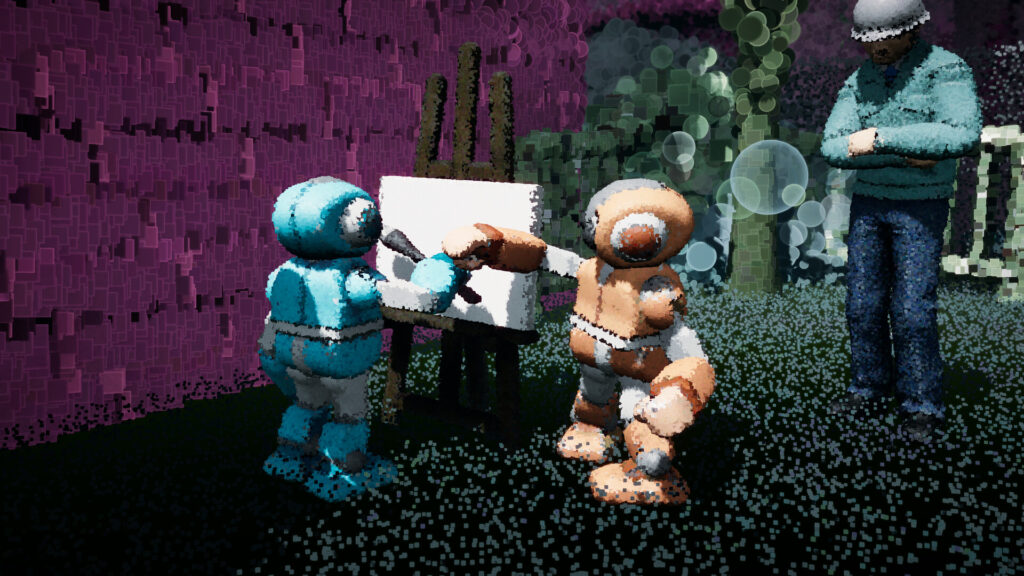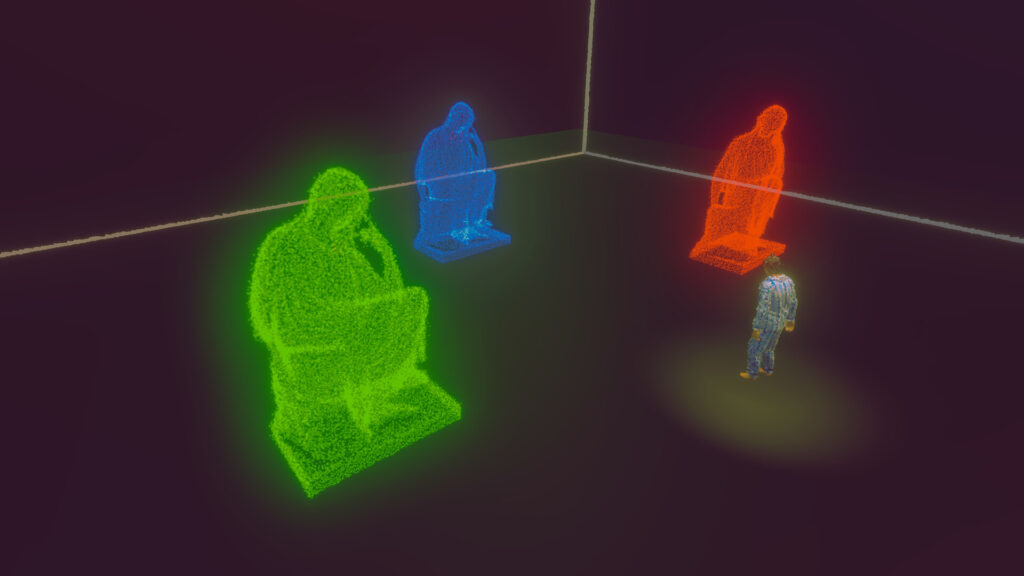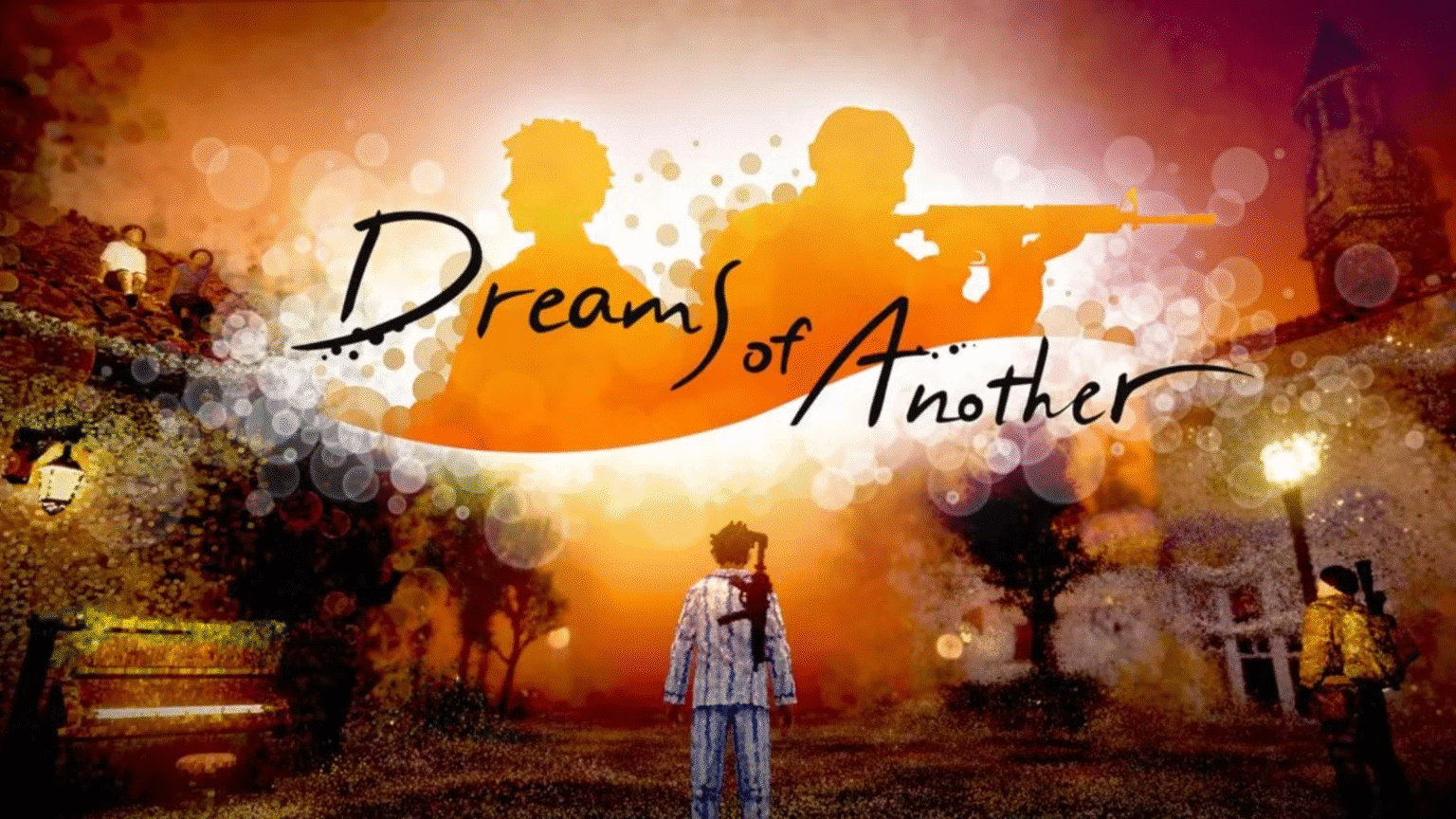There are games that entertain you, and then there are games that ask you to think. Dreams of Another, from Q-Games Ltd.—the studio behind The Tomorrow Children and the PixelJunk series—is one of the latter. It’s not just a game, but a surreal art piece wrapped in digital form, a lucid dream you inhabit rather than play.
Built on the studio’s cutting-edge point cloud rendering technology, this third-person exploration-action experience embodies its central philosophical idea: “No Creation Without Destruction.” Every pull of the trigger is an act of genesis, every bullet brings something new into existence. It’s a paradox, a poem, and a quiet rebellion against what we expect from games.
We played it on PC and PSVR2, and the result was one of the most meditative, disorienting, and strangely beautiful experiences we’ve had all year.
The Premise – When Shooting Creates
At its core, Dreams of Another turns one of gaming’s oldest mechanics—shooting—into a creative act. You don’t destroy enemies or obstacles here. Instead, firing your weapon materializes the world itself. The scenery, the objects, even memories are brought to life through your actions.
The game begins with The Wandering Soldier, frozen mid-battle, unable to pull the trigger. His hesitation ends his life—but begins his dream. Soon, you awaken as The Man in Pajamas, drifting through a fragmented landscape of half-formed worlds, piecing together memories that belong not to you, but to others.
You walk through floating pixels and nebulous fogs of light, each shot revealing fragments of furniture, faces, forests, and long-lost echoes of consciousness. The more you explore, the more the dream reshapes itself.
It’s hypnotic. Confusing. Occasionally frustrating. But it’s also genuinely profound.

Philosophy in Motion – “No Creation Without Destruction”
The tagline isn’t just aesthetic fluff—it’s the beating heart of the experience. Every design choice in Dreams of Another reflects this duality: progress through decay, understanding through loss, creation through destruction.
The game constantly juxtaposes life and death, dream and waking, memory and oblivion. Even small moments—a door speaking about its loneliness, a tree reflecting on how roots and branches grow in opposite directions—carry metaphorical weight.
And yet, for all its abstraction, the message is accessible. You’re invited to feel before you understand. It’s less about deciphering a puzzle and more about recognizing an emotion.
It’s the kind of narrative that lingers long after you exit the game—unresolved, but resonant.
Gameplay – A Shooter that Breathes Instead of Bleeds
Mechanically, Dreams of Another borrows the language of third-person shooters but redefines it entirely. You shoot not to kill but to reveal.
The environment is filled with aura fog, a dense field of particles representing uncertainty and potential. Shooting into this fog “creates” the world in real time—bridges appear, doors solidify, ruins reconstruct themselves, and surreal creatures emerge to speak in riddles.
There are no enemies, no deaths, and no game over screens. Instead, the tension comes from curiosity: What will I uncover next?
As you progress, you gain access to new tools—grenades, a bazooka, and other firearms—all of which serve as instruments of creation, expanding the scope of what can be materialized.
It’s not action in the conventional sense—it’s sculpting a dream.
Storytelling – Fragments of a Shared Consciousness
Narratively, Dreams of Another functions like a collage of overlapping dream sequences. You drift between perspectives and lives: the Man in Pajamas, the Wandering Soldier, a family of moles, even sentient objects like chairs and bells.
Each vignette is connected by tone rather than logic. You might be exploring an abandoned amusement park one moment and descending into the memories of a household pet the next.
The dialogue, intentionally stilted and abstract, reflects dream logic. Characters say things that make no immediate sense but echo with meaning when you reflect on them later:
“We trees grow not just upward, but downward too. Depending on how you look at it, up can be down.”
“Nothing can be created from nothing. But even destruction leaves behind a shadow.”
This writing, paired with the game’s hushed pacing, evokes a strange kind of introspection. You’re not chasing plot points—you’re meditating on connections.
Visuals – Worlds Born from Light
Q-Games’ use of point cloud rendering gives Dreams of Another a visual identity unlike anything else. Every object, character, and environment is made up of floating particles—thousands of points suspended in space, constantly shifting, never fully solid.
It’s as if the world is half-dreaming itself into existence as you walk through it.
At first, it’s breathtaking. Later, it’s disorienting. But that’s the point—the visual instability mirrors the psychological instability of dreaming.
On PSVR2, the effect is even more powerful. The 3D depth of the particles makes you feel as if you’re walking through a living painting, and the subtle eye-tracking shooting adds an extra layer of immersion.
However, not everything works perfectly. Some areas look unfinished, almost too sparse, and the heavy flicker of certain light sources can strain the eyes. Still, it’s a small price to pay for such a bold artistic vision.

Audio – A Soundtrack for Dreamers
Composer and director Baiyon also handled the game’s music, and it shows. The soundtrack is a textured blend of ambient electronica, melancholic piano, and industrial drones that seem to hum from inside the dream itself.
It’s music that breathes. Sometimes it comforts, sometimes it unsettles, but it always feels alive.
Sound design plays a huge role, too. The sharp “blip” when a bullet materializes matter, the hum of a forming structure, and the reverb of distant conversations all contribute to a sense of fragile reality.
The voice acting, on the other hand, is divisive. Some performances are flat, robotic even—but in a strange way, that works. It makes the world feel detached, uncanny, and otherworldly. The moles—yes, moles—deliver some of the most memorable and oddly emotional lines in the entire game.
Pacing and Structure – The Loop of Dreams
Dreams of Another unfolds like a series of lucid dreams. Each “chapter” feels self-contained, yet subtly connected.
When you finish a section, you’re returned to the title screen—only to dive back in again, as if falling asleep once more. The repetition is intentional, mirroring the rhythm of dreaming and forgetting.
That said, this structure won’t work for everyone. The pacing is slow. Some dialogues linger a bit too long, and there’s no way to skip them. Players expecting constant interactivity may find themselves impatient.
But if you surrender to the rhythm—if you treat it as meditation rather than gameplay—you’ll find it deeply rewarding.
A Reflection on Art, Memory, and Existence
At its heart, Dreams of Another is about connection. Between destruction and creation, artist and audience, dream and dreamer.
It challenges the idea that games must be about competition or mastery. Instead, it asks: Can games simply be about reflection?
Even the game’s “failures”—its awkward pacing, its abstract story, its uneven tone—become part of the message. Dreams don’t make sense. They aren’t supposed to. But they mean something to the dreamer.
By the time the credits roll, you’re not sure what you’ve just experienced—but you know it mattered.
A Fragile Masterpiece for the Patient
Dreams of Another is not for everyone. It’s not exciting, fast, or conventional. It’s strange, slow, and achingly philosophical. But it’s also one of the most artistically ambitious games of 2025.
For those willing to step into its world, it offers something rare: a game that doesn’t just show you a dream, but lets you live inside one.
It’s messy, it’s mesmerizing, and it might just change how you think about games altogether.
Pros:
- Breathtaking point cloud visuals
- Innovative creation-based shooting mechanic
- Deep philosophical storytelling
- Gorgeous and haunting soundtrack
- Strong VR implementation
Cons:
- Uneven pacing and overly long dialogue
- Occasional visual clutter and eye strain
- Flat voice acting in some scenes
Dreams of Another: Dreams of Another isn’t just a game—it’s a reflection on creativity itself. In a landscape dominated by predictable formulas, Q-Games has crafted something rare and brave: a dream that dares to ask what it means to create. And in doing so, it reminds us that destruction and beauty often walk hand in hand. – Obsidian


